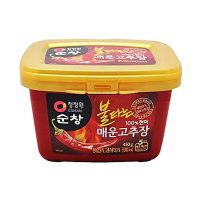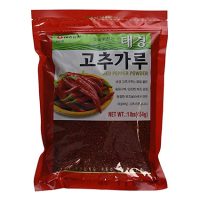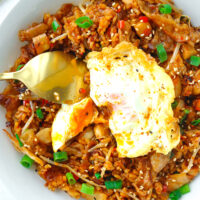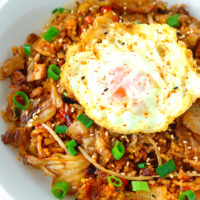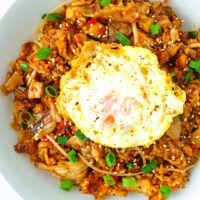 Buy Now →
Buy Now → Kimchi Fried Rice with Pork Belly
An easy to make one wok Korean fried rice that is full of BIG and BOLD flavors and ready in under 30 minutes! It’s made with thinly sliced pork belly meat, kimchi, fragrant aromatics, a few veggies, and the most delicious gochujang infused spicy, smoky, and tangy sauce with a hint of sweetness!
- Prep Time: 15
- Cook Time: 12
- Total Time: 27 minutes
- Yield: 4 1x
- Category: Dinner
- Method: Stir-fry
- Cuisine: Korean
Ingredients
Scale
For the Kimchi Fried Rice with Pork Belly:
- 2 TBLS Canola Oil (or any neutral flavored cooking oil with a high smoke point)
- 4 large Eggs
- ½ medium Yellow Onion – finely chopped
- 1 large Spring Onion – finely chopped, white and light green parts separated from dark green parts
- 6 Garlic cloves – minced
- 2 TBLS grated Ginger
- 2 – 12 Red Chilies (Thai Bird’s Eye chilies or any other small hot red chilies), to taste – finely chopped
- 1 piece (about 100 – 130 grams / 3.5 – 4.5 ounces) King Oyster Mushroom – sliced into ¼-inch wide discs, then cut into 1-cm cubes
- ¾ cup Kimchi + 1-2 TBLS Kimchi Juice (liquid from kimchi jar) – chopped
- 1 cup Mung Bean Sprouts – rinsed and drained
- 3 cups cooked Long Grain Rice (Such as Thai jasmine rice. Cold day-old rice works best.)
- ½ TSP freshly cracked Black Pepper, to taste
- ¼ TSP Kosher Salt, to taste
- To Serve: Toasted white sesame seeds, reserved spring onion dark green parts, fried egg, sprinkling of shichimi togarashi (Japanese assorted chili pepper) for the egg
For the Pork Marinade:
- ½ TBLS Gochujang
- ½ TBLS Low Sodium Light Soy Sauce
- ½ TBLS Korean Sake (optional)
- ¼ TSP freshly cracked Black Pepper
- 1 TSP Sesame Oil
- 215 – 240 grams / 7.5 – 8.5 ounces thinly sliced Pork Belly (hotpot/shabu shabu style meat) – cut into 1.5-inch wide strips
For the Sauce:
- 2 TBLS Gochujang
- 2 TBLS Low Sodium Light Soy Sauce
- ¾ TBLS Distilled White Vinegar
- 1 TSP Sesame Oil
- ½ – 1 TSP Chili Oil (optional – pure chili oil without flakes/seeds), to taste
- 1 TSP Gochugaru, to taste (substitute with chili powder if unavailable)
- 1 TSP Toasted White Sesame Seeds
- 1 TSP White Sugar, to taste
Instructions
Prep:
- Prepare all the fresh ingredients: Chop the yellow onion, spring onion (separate the white and light green parts from the dark green parts), garlic, red chilies, and king oyster mushroom as indicated in the ingredients section. Grate the ginger directly into a small bowl, and spoon the kimchi and kimchi juice into a small measuring cup. Use kitchen scissors to cut the kimchi into small pieces in the cup. Rinse and drain the mung bean sprouts. Set everything aside.
- Marinate the pork belly: Combine the gochujang, low sodium light soy sauce, Korean sake (if using), freshly cracked black pepper, and sesame oil in a medium sized bowl. Mix until combined well. Slice the pork into 1.5-inch wide strips and add to the bowl. Mix until the pork is evenly coated in the marinade, then set aside.
- Make the sauce: Whisk together the gochujang, low sodium light soy sauce, distilled white vinegar, sesame oil, chili oil (if using), toasted white sesame seeds, and white sugar in a small measuring cup (for easier pouring) or bowl until evenly combined.
For the Kimchi Fried Rice with Pork Belly:
- Fry the eggs: Heat 2 tablespoons of oil in a large wok or heavy bottomed deep frying pan over medium-high heat. Once the oil is hot, crack the egg into it and cook, spooning the surrounding oil over the top as it fries, until your desired doneness for the yolk is reached. Transfer to a paper towel lined plate and set aside. Repeat with the remaining 3 eggs.
- Sauté onions: Add 1/2 tablespoon of oil to the wok if needed and heat over high heat. Once hot, add the yellow onion and spring onion white and light green parts. Sauté until translucent – about 30 seconds.
- Add aromatics: Add the garlic, ginger, and red chilies. Stir-fry for 30 seconds until fragrant.
- Cook the pork: Make a well in the center of the wok by pushing everything to the edges of the wok. Add the marinated pork and spread the pieces out in the center of the wok. Let the pork sear for about a minute before flipping the pieces over and allowing the other side to sear for 30 more seconds. Then stir-fry to combine everything.
- Cook the mushrooms and kimchi: Add the chopped king oyster mushrooms and stir-fry for a minute to combine with everything until slightly softened. Make a well in the center of the wok again and add the kimchi and kimchi juice. Stir-fry in the center of the wok so that there is direct contact with it for 20 seconds, then toss to combine with everything.
- Add the rice and sauce: Add the rice and pour the sauce on top. Stir-fry using a scooping motion until everything is evenly coated in the sauce.
- Season: Season with kosher salt and freshly cracked black pepper. Toss to combine, then let everything sit for 15-20 seconds. Then toss everything again and let everything sit for another 15-20 seconds. This helps the rice to get a little crisp in some parts and prevents it from becoming mushy.
- Toss through spring onion greens and bean sprouts: Add the spring onion green parts and bean sprouts. Toss to combine for 15-20 seconds until the bean sprouts have slightly softened, then switch off the heat.
- To Serve: Divide the fried rice into four plates/bowls and drizzle a little sesame oil on top. Garnish with a sprinkling of toasted white sesame seeds and the remaining spring onion dark green parts. Top each plate/bowl with a fried egg and sprinkle shichimi togarashi on top of the egg if desired. Serve immediately.
Notes
- Gochujang and gochugaru. Gochujang is a fermented Korean chili pepper paste that comes in small tubs. In spite of its deep dark red color, it’s not extremely spicy. It has a spicy-sweet and smoky flavor profile. Gochugaru is a Korean hot pepper powder. Look for them in the Asian aisle of supermarkets or in Asian and Korean supermarkets. Depending on the brand, gochugaru can come in varying heat levels. Adjust quantity to taste, or substitute with chili powder instead.
- Kimchi and kimchi juice. Kimchi is a Korean spicy fermented cabbage that comes in either jars, cans, or packages. It’s usually made with cabbage, radish, sometimes carrots, as well as plenty of other seasonings such as fish sauce, gochugaru, garlic, and ginger. Look for it in the fridge section of some large supermarkets that are well-stocked with international ingredients, or in Asian and Korean supermarkets. Depending on the brand and how old the kimchi is, the degree of sourness will vary. Kimchi juice is the liquid at the bottom of the package or jar of kimchi and not a separate ingredient. Your jar may not always have a lot of kimchi juice, so add more distilled white vinegar if more sour flavors are needed.
- Adjust spice level to taste. If you prefer to make this milder, use less gochujang for the fried rice sauce (1 tablespoon), gochugaru (half teaspoon), and less fresh red chilies (to taste).
- Storage and leftovers: Store in a sealed airtight container in the fridge for up to 3 days. Reheat in the microwave for on high 1-2 minutes until hot throughout.
- See ‘Variations’ section above if you’d like to customize this kimchi fried rice.
Nutrition
- Serving Size: 1/4 of recipe
- Calories: 603
- Sugar: 13.3g
- Sodium: 1153.2mg
- Fat: 33.6g
- Saturated Fat: 2.7g
- Unsaturated Fat: 12.4g
- Trans Fat: 0g
- Carbohydrates: 58.2g
- Fiber: 3.5g
- Protein: 18g
- Cholesterol: 186mg
Find it online: https://thatspicychick.com/kimchi-fried-rice-with-pork-belly/

